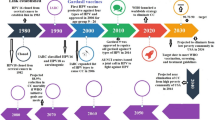Abstract
Cervical cancer screening with human papillomavirus (HPV) DNA testing has potential advantages over conventional smear testing in that it can predict cases in which invasive cancers are more likely to develop, may be cheaper to implement and improve compliance. In areas of the world where little formalised cervical cancer screening takes place, or where health resources are limited, HPV testing has been suggested as a possible alternative for primary screening.
In this paper we demonstrate the use of mathematical modelling to evaluate the effects of setting up screening programmes in Eastern Europe with HPV DNA testing as the primary screening tool and compare it with conventional smear testing. The impact of screening is measured in terms of the life years gained and the resulting resource usage and cost. We investigate several screening options with different screening intervals and age ranges for the target population.
Similar content being viewed by others
References
R. Sankaranarayanan and P. Pisani, Prevention measures in the Third World: are they practical?, in: New Developments in Cervical Cancer Screening and Prevention, eds. E. Franco and J. Monsonego (Blackwell Science, Oxford, 1997).
F.X. Bosch et al., Prevalence of human papillomavirus in cervical cancer: a worldwide perspective, Journal of the National Cancer Institute 87 (1995) 796–802.
M.H. Schiffman and M.E. Sherman, HPV testing to improve cervical cancer screening, in: Early Detection of Cancer: Molecular Markers, eds. S. Srivastava, S.M. Lippman, W.K. Hong and J.L. Mulshine (Futura, Armonk, NY, 1994).
D. Jenkins, C. Sherlaw-Johnson and S. Gallivan, Assessing the role of HPV testing in cervical cancer screening, Papillomavirus Report 9 (1998) 89–101.
C.J.L.M. Meijer et al., Human papillomavirus testing for primary cervical cancer screening, in: New Developments in Cervical Cancer Screening and Prevention, eds. E. Franco and J. Monsonego (Blackwell Science, Oxford, 1997).
T.H. Tulchinsky and E.A. Varavikova, Addressing the epidemiologic transition in the former Soviet Union: strategies for health system and public health reform in Russia, American Journal of Public Health 86 (1996) 313–320.
M. Chen and M. Mastilica, Health care reform in Croatia: for better or for worse, American Journal of Public Health 88 (1998) 1156–1160.
D. Jenkins, C. Sherlaw-Johnson and S. Gallivan, Can papillomavirus testing be used to improve cervical cancer screening?, International Journal of Cancer 65 (1996) 768–773.
C. Sherlaw-Johnson, S. Gallivan and D. Jenkins, Evaluating cervical cancer screening programmes for developing countries, International Journal of Cancer 72 (1997) 210–216.
D.M. Parkin et al., eds., Cancer Incidence in Five Continents, Vol. VII, IARC Publications 143 (International Agency for Research on Cancer, Lyon, 1997).
J. Cuzick et al., Human papillomavirus testing in primary cervical screening, The Lancet 345 (1995) 1533–1536.
L.A. Koutsky et al., A cohort study of the risk of cervical intraepithelial neoplasia grade 2 or 3 in relation to papillomavirus infection, New England Journal of Medicine 327 (1992) 1272–1278.
R.M. Richart and B.A. Barron, A follow-up study of patients with cervical dysplasia, American Journal of Obstetrics and Gynecology 105 (1969) 386–393.
M.J. Campion, D.J. McCance, J. Cuzick and A. Singer, Progressive potential of mild cervical atypia: prospective cytological, colposcopic and virological study, The Lancet ii (1986) 237–240.
P.W.J. Melkert et al., Prevalence of HPV in cytomorphologically normal cervical smears, as determined by the polymerase chain reaction, is age-dependent, International Journal of Cancer 53 (1993) 919–923.
L.J. Eron et al., Interferon therapy for condylomata acuminata, New England Journal of Medicine 315 (1986) 1059–1064.
United Nations, Demographic Yearbook, 48th ed. (United Nations, New York, 1998).
M. Quinn, P. Babb, J. Jones and E. Allen, On behalf of the United Kingdom Association of Cancer Registries, Effect of screening on incidence and mortality from cancer of cervix in England: evaluation based on routinely collected statistics, British Medical Journal 318 (1999) 904–908.
G. Gatta, M.B. Lasota, A. Verdecchia and the EUROCARE Working Group, Survival of European women with gynaecological tumours, during the period 1978-1989, European Journal of Cancer 34 (1998) 2218–2225.
Department of Health, Cervical Screening Programme, England: 1995-96, Statistical Bulletin 1996/26 (Government Statistical Service, London, 1996).
N. Waugh et al., Costs and benefits of cervical screening. I. The costs of the cervical screening programme, Cytopathology 7 (1996) 231–240.
J.L. Wolstenholme and D.K. Whynes, Stage-specific treatment costs for cervical cancer in the United Kingdom, European Journal of Cancer 34 (1998) 1889–1893.
J. Cuzick and P. Sasieni, Estimates of the cost impact of introducing human papillomavirus testing into a cervical screening programme, in: New Developments in Cervical Cancer Screening and Prevention, eds. E. Franco and J. Monsonego (Blackwell Science, Oxford, 1997).
J. Mandelblatt, C. Schechter, M. Fahs and C. Muller, Clinical implications of screening for cervical cancer under Medicare. The natural history of cervical cancer in the elderly: What do we know? What do we need to know?, American Journal of Obstetrics and Gynecology 164 (1991) 644–651.
D.M. Parkin, The epidemiological basis for evaluating screening policies, in: New Developments in Cervical Cancer Screening and Prevention, eds. E. Franco and J. Monsonego (Blackwell Science, Oxford, 1997).
Author information
Authors and Affiliations
Rights and permissions
About this article
Cite this article
Sherlaw-Johnson, C., Gallivan, S. The planning of cervical cancer screening programmes in Eastern Europe: is viral testing a suitable alternative to smear testing?. Health Care Management Science 3, 323–329 (2000). https://doi.org/10.1023/A:1019074214801
Issue Date:
DOI: https://doi.org/10.1023/A:1019074214801




